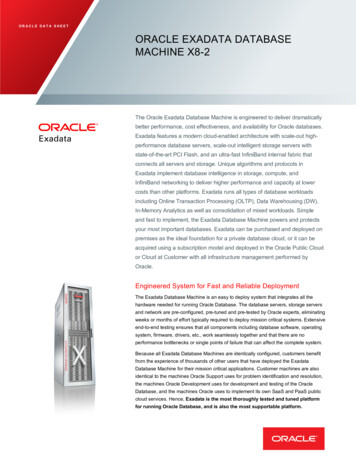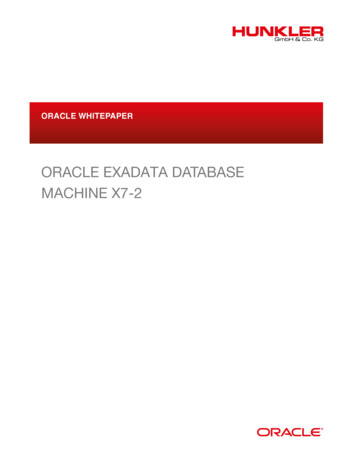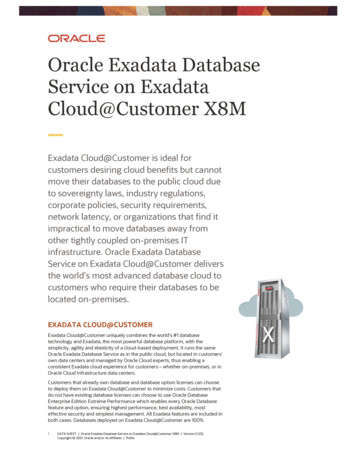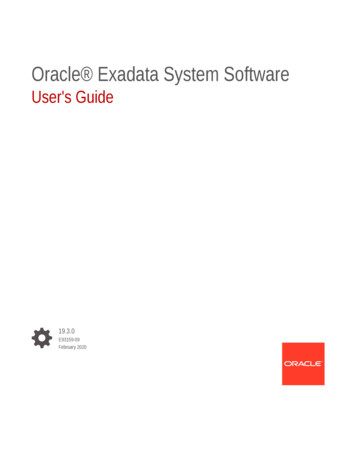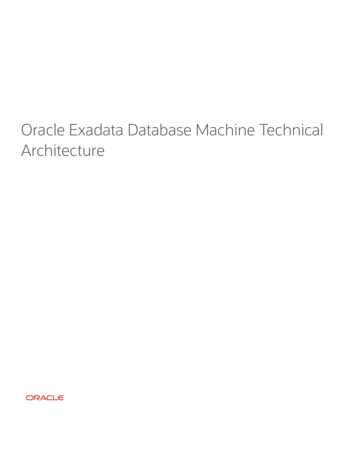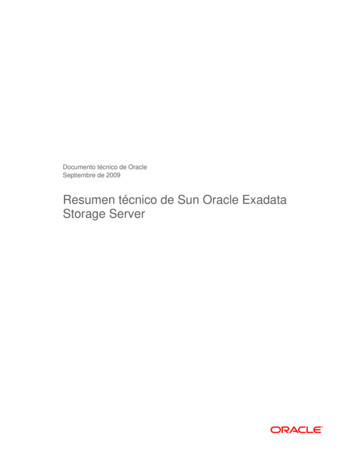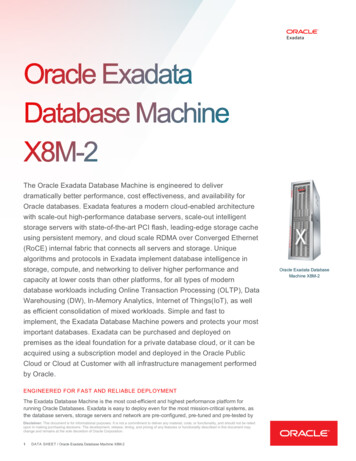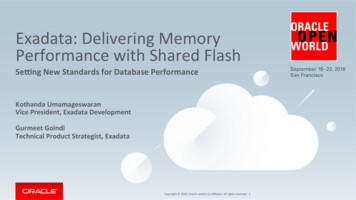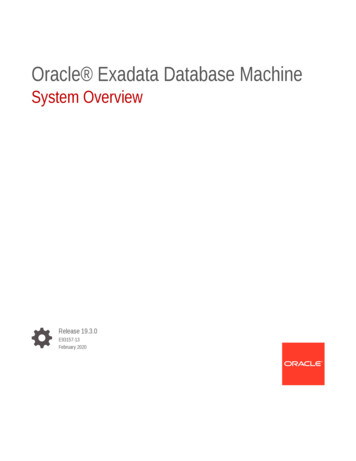
Transcription
Oracle Exadata Database MachineSystem OverviewRelease 19.3.0E93157-13February 2020
Oracle Exadata Database Machine System Overview, Release 19.3.0E93157-13Copyright 2008, 2020, Oracle and/or its affiliates.Primary Author: Janet SternContributors: Doug Archambault, Leo Agranonik, Andrew Babb, Nilesh Choudhury, Henry Chow, RavindraDani, Boris Erlikhman, Jaime Figueroa, Gurmeet Goindi, Roger Hansen, Leslie Keller, Frank Kobylanski,René Kundersma, Sue Lee, Jennifer Leung, Yang Liu, Juan Loaiza, Barb Lundhild, Catherine Luu, PhilipNewlan, Adrian Ng, Dan Norris, Michael Nowak, Bharat Paliwal, Hector Pujol, Dmitry Potapov, DarrylPresley, Ashish Ray, Richard Scales, Oliver Sharwood, Jia Shi, Kesavan Srinivasan, Mahesh Subramaniam,Krishnadev Telikicherla, Cliff Thomas, Alex Tsukerman, Shreyas Udgaonkar, Kothanda Umamageswaran,Doug Utzig, James Viscusi, Vern Wagman, Zheren ZhangThis software and related documentation are provided under a license agreement containing restrictions onuse and disclosure and are protected by intellectual property laws. Except as expressly permitted in yourlicense agreement or allowed by law, you may not use, copy, reproduce, translate, broadcast, modify,license, transmit, distribute, exhibit, perform, publish, or display any part, in any form, or by any means.Reverse engineering, disassembly, or decompilation of this software, unless required by law forinteroperability, is prohibited.The information contained herein is subject to change without notice and is not warranted to be error-free. Ifyou find any errors, please report them to us in writing.If this is software or related documentation that is delivered to the U.S. Government or anyone licensing it onbehalf of the U.S. Government, then the following notice is applicable:U.S. GOVERNMENT END USERS: Oracle programs (including any operating system, integrated software,any programs embedded, installed or activated on delivered hardware, and modifications of such programs)and Oracle computer documentation or other Oracle data delivered to or accessed by U.S. Government endusers are "commercial computer software" or “commercial computer software documentation” pursuant to theapplicable Federal Acquisition Regulation and agency-specific supplemental regulations. As such, the use,reproduction, duplication, release, display, disclosure, modification, preparation of derivative works, and/oradaptation of i) Oracle programs (including any operating system, integrated software, any programsembedded, installed or activated on delivered hardware, and modifications of such programs), ii) Oraclecomputer documentation and/or iii) other Oracle data, is subject to the rights and limitations specified in thelicense contained in the applicable contract. The terms governing the U.S. Government’s use of Oracle cloudservices are defined by the applicable contract for such services. No other rights are granted to the U.S.Government.This software or hardware is developed for general use in a variety of information management applications.It is not developed or intended for use in any inherently dangerous applications, including applications thatmay create a risk of personal injury. If you use this software or hardware in dangerous applications, then youshall be responsible to take all appropriate fail-safe, backup, redundancy, and other measures to ensure itssafe use. Oracle Corporation and its affiliates disclaim any liability for any damages caused by use of thissoftware or hardware in dangerous applications.Oracle and Java are registered trademarks of Oracle and/or its affiliates. Other names may be trademarks oftheir respective owners.Intel and Intel Inside are trademarks or registered trademarks of Intel Corporation. All SPARC trademarks areused under license and are trademarks or registered trademarks of SPARC International, Inc. AMD, Epyc,and the AMD logo are trademarks or registered trademarks of Advanced Micro Devices. UNIX is a registeredtrademark of The Open Group.This software or hardware and documentation may provide access to or information about content, products,and services from third parties. Oracle Corporation and its affiliates are not responsible for and expresslydisclaim all warranties of any kind with respect to third-party content, products, and services unless otherwiseset forth in an applicable agreement between you and Oracle. Oracle Corporation and its affiliates will not beresponsible for any loss, costs, or damages incurred due to your access to or use of third-party content,products, or services, except as set forth in an applicable agreement between you and Oracle.
ContentsPreface1AudiencexvDocumentation AccessibilityxvConventionsxvIntroduction to Oracle Exadata Database Machine and OracleExadata Storage Expansion Rack1.1Oracle Exadata Database Machine Architecture1-11.2Oracle Exadata Database Machine Configurations1-21.3Oracle Exadata Database Machine Performance Features1-31.4Oracle Exadata Rack Restrictions1-41.4.1Restrictions for Modifying Oracle Exadata Rack Hardware1-41.4.2Restrictions for Modifying the Oracle Exadata Database MachineSoftware Components1-5Restrictions for Connecting Oracle Exadata Database Machine withOther Hardware, Systems, or Networks1-61.4.3Part I2Hardware ComponentsHardware Components of Oracle Exadata Database Machine2.1Oracle Exadata Database Machine Hardware Components by Model2.2Oracle Exadata Database Server Hardware Components2.2.12.2.22.2.32.2.42.2.52-12-22Database Server Components of Oracle Exadata Database MachineX8M-22-23Database Server Components of Oracle Exadata Database MachineX8M-82-23Database Server Components of Oracle Exadata Database MachineX8-22-24Database Server Components of Oracle Exadata Database MachineX8-82-24Database Server Components of Oracle Exadata Database MachineX7-22-24iii
2.2.152.3Database Server Components of Oracle Exadata Database MachineX6-22-25Database Server Components of Oracle Exadata Database MachineX5-22-26Database Server Components of Oracle Exadata Database MachineX5-8 and X6-82-26Database Server Components of Oracle Exadata Database MachineX4-22-26Database Server Components of Oracle Exadata Database MachineX4-8 Full Rack2-27Database Server Components of Oracle Exadata Database MachineX3-22-27Database Server Components of Oracle Exadata Database MachineX3-8 Full Rack2-28Database Server Components of Oracle Exadata Database MachineX2-22-28Database Server Components of Oracle Exadata Database MachineX2-8 Full Rack2-292-30Extreme Flash Exadata Storage Server X8M-2 and X8-2 HardwareComponents2-31High Capacity Exadata Storage Server X8-2 and X8M-2 HardwareComponents2-31Extended Exadata Storage Server X8-2 and X8M-2 HardwareComponents2-322.3.4Extreme Flash Exadata Storage Server X7-2 Hardware Components2-322.3.5High Capacity Exadata Storage Server X7-2 Hardware Components2-332.3.6Extreme Flash Exadata Storage Server X6-2 Hardware Components2-332.3.7High Capacity Exadata Storage Server X6-2 Hardware Components2-332.3.8Extreme Flash Exadata Storage Server X5-2 Hardware Components2-342.3.9High Capacity Exadata Storage Server X5-2 Hardware Components2-342.3.22.3.32.3.10Exadata Storage Server X4-2L Hardware Components2-342.3.11Exadata Storage Server X3-2L Hardware Components2-352.3.12Exadata Storage Server with Sun Fire X4270 M2 Servers HardwareComponents2-35Exadata Storage Server with Sun Fire X4275 Servers HardwareComponents2-352.3.1332-25Oracle Exadata Storage Server Hardware Components2.3.12.4Database Server Components of Oracle Exadata Database MachineX7-8Spares Kit Components for Oracle Exadata Database Machine2-36Hardware Components of the Exadata Storage Expansion Rack3.1Components of Oracle Exadata Storage Expansion Rack X8M-23-13.2Components of Oracle Exadata Storage Expansion Rack X8-23-2iv
3.3Components of Oracle Exadata Storage Expansion Rack X7-23-23.4Components of Oracle Exadata Storage Expansion Rack X6-23-33.5Components of Oracle Exadata Storage Expansion Rack X5-23-33.6Components of Oracle Exadata Storage Expansion Rack X4-23-43.7Components of Oracle Exadata Storage Expansion Rack X3-23-53.8Components of Oracle Exadata Storage Expansion Rack with ExadataStorage Server with Sun Fire X4270 M2 Servers3-6Spares Kit Components for Oracle Exadata Storage Expansion Rack3-73.9Part IICabling Information for Oracle Exadata Database Machine4Elastic Configurations5Cabling Tables for Oracle Exadata Database Machine X8M5.1Rack Layout Diagrams5-15.2Integrated Lights Out Manager (ILOM) Cabling Tables5-35.3Administrative Ethernet Port Cabling Tables5-55.4Single Phase Power Distribution Unit Cabling Tables5-75.4.15.4.25.55.5.265-8Single Phase PDU Cabling for Oracle Exadata Database MachineX8M-8 Full Rack5-9Three-Phase Power Distribution Unit Cabling Tables5.5.15.6Single Phase PDU Cabling for Oracle Exadata Database MachineX8M-2 Full Rack5-10Three-Phase PDU Cabling for Oracle Exadata Database MachineX8M-2 Full Rack5-10Three Phase PDU Cabling for Oracle Exadata Database MachineX8M-8 Full Rack5-11RDMA Network Fabric Network Cabling Tables5-125.6.1RDMA Network Fabric Network Cabling Tables for X8M-2 Racks5-135.6.2RDMA Network Fabric Network Cabling Tables for X8M-8 Racks5-16Cabling Tables for Oracle Exadata Database Machine X8-2, X8-8,X7-2, and X7-86.1Rack Layout Diagrams6-16.2Sun Integrated Lights Out Manager Cabling Tables6-46.3Administrative Gigabit Ethernet Port Cabling Tables6-56.4Single Phase Power Distribution Unit Cabling Tables6-76.4.1Single Phase PDU Cabling for Oracle Exadata Database Machine X8-2Full Rack6-8v
6.4.26.4.36.4.46.56.5.26.5.36.5.47896-9Single Phase PDU Cabling for Oracle Exadata Database Machine X7-2Full Rack6-10Single Phase PDU Cabling for Oracle Exadata Database Machine X7-8Full Rack6-11Three-Phase Power Distribution Unit Cabling Tables6.5.16.6Single Phase PDU Cabling for Oracle Exadata Database Machine X8-8Full Rack6-12Three-Phase PDU Cabling for Oracle Exadata Database Machine X8-2Full Rack6-12Three Phase PDU Cabling for Oracle Exadata Database Machine X8-8Full Rack6-13Three-Phase PDU Cabling for Oracle Exadata Database Machine X7-2Full Rack6-14Three Phase PDU Cabling for Oracle Exadata Database Machine X7-8Full Rack6-15InfiniBand Network Cabling Tables6-16Cabling Tables for Oracle Exadata Database Machine X6-2, X6-8,X5-2, and X5-87.1Rack Layout Diagrams7-17.2Sun Integrated Lights Out Manager Cabling Tables7-67.3Administrative Gigabit Ethernet Port Cabling Tables7-97.4Single Phase Power Distribution Unit Cabling Tables7-127.5Three Phase Power Distribution Unit Cabling Tables7-157.6InfiniBand Network Cabling Tables7-18Cabling Tables for Oracle Exadata Database Machine X4-2 andOracle Exadata Database Machine X4-8 Full Rack8.1Rack Layout Diagrams8-18.2Sun Integrated Lights Out Manager Cabling Tables8-58.3Administrative Gigabit Ethernet Port Cabling Tables8-88.4Single Phase Power Distribution Unit Cabling Tables8-118.5Three Phase Power Distribution Unit Cabling Tables8-148.6InfiniBand Network Cabling Tables8-17Cabling Tables for Oracle Exadata Database Machine X3-2 andOracle Exadata Database Machine X3-8 Full Rack9.1Rack Layout Diagrams9-19.2Sun Integrated Lights Out Manager Cabling Tables9-59.3Administrative Gigabit Ethernet Port Cabling Tables9-8vi
10119.4Single Phase Power Distribution Unit Cabling Tables9-119.5Three Phase Power Distribution Unit Cabling Tables9-149.6InfiniBand Network Cabling Tables9-17Cabling Tables for Oracle Exadata Database Machine X2-2 andOracle Exadata Database Machine X2-8 Full Rack10.1Rack Layout Diagrams10-110.2Keyboard, Video and Mouse Network Cabling Tables10-510.3Sun Integrated Lights Out Manager Cabling Tables10-710.4Administrative Gigabit Ethernet Port Cabling Tables10-910.5Single Phase Power Distribution Unit Cabling Tables10-1210.6Three Phase Power Distribution Unit Cabling Tables10-1510.7InfiniBand Network Cabling Tables10-18Cabling Tables for Oracle Exadata Storage Expansion Rack11.1Storage Expansion Rack Layout Diagrams11-111.2Integrated Lights Out Manager (ILOM) Cabling Tables11-811.3Administrative Network Cabling Tables11-1311.4Single Phase Power Distribution Unit Cabling Tables11-2011.5Three Phase Power Distribution Unit Cabling Tables11-2811.6RDMA Network Fabric Network Cabling Tables11-3711.6.111.6.211.6.311.6.4Part III12RDMA Network Fabric Cabling for Oracle Exadata Storage ExpansionRack X8M-211-38InfiniBand Network Cabling for Oracle Exadata Storage ExpansionX7-2, X6-2 and X5-211-39InfiniBand Network Cabling for Oracle Exadata Storage ExpansionRack X4-2 and X3-211-41InfiniBand Network Cabling for Oracle Exadata Storage Expansionwith Sun Fire X4270 M2 Servers11-50What's New in Oracle Exadata Database MachineNew Features for Oracle Exadata System Software Release 19.x12.1What's New in Oracle Exadata Database Machine 19.3.012-112.1.1Persistent Memory Data Accelerator12-112.1.2Persistent Memory Commit Accelerator12-212.1.3Support for Oracle Exadata X8M Systems12-212.1.4Instant Failure Detection for X8M Systems12-312.1.5KVM for Virtual Environments12-3vii
12.1.6Faster Encrypted Table Smart Scans12-312.1.7Smart Aggregation12-412.1.8Smart In-Memory Columnar Cache with Row IDs12-512.1.9Smart In-memory Columnar Cache with Chained Rows12-512.1.10Fast Smart In-memory Columnar Cache Creation12-512.1.11Encryption of System Logs to Remote Destinations12-612.1.12Update a Single SNMP User Definition12-612.1.13Securing Storage Server Software Processes with Memory ProtectionKeys12-612.1.14Default XFS File System for X8M Servers12-612.1.15Oracle Linux Kernel to Unbreakable Enterprise Kernel 5 and OracleLinux Distribution Upgraded to Oracle Linux 7.712-7Software Certification Ends for Exadata Database Machine X2Servers12-712.1.1612.2What's New in Oracle Exadata Database Machine 19.2.012-812.2.1Support for New Hardware - X8 Servers12-812.2.2Oracle Exadata Storage Server X8-2 Extended (XT)12-812.2.3Changes to IORM flashcachesize Attribute and Hard Disk I/O Limits12-812.3What's New in Oracle Exadata Database Machine 19.1.012-912.3.1Oracle Linux Upgraded to Oracle Linux 7.512.3.2Automated Cloud Scale Performance Monitoring12-1012.3.3Faster Smart Scans Using Column-level Checksum12-1112.3.4Enhanced OLTP High Availability During Cell Outages and FlashFailures12-1112.3.5Support for Host and ILOM on Separate Network12-1212.3.6DB UNIQUE NAME Support for Multiple Clusters Sharing ExadataStorage12-13Secure Eraser Updates12-1412.3.712.3.7.112-9Automatic Upgrading of Multi-pass Disk Erasure to SecureEraser12-1412.3.7.2Automatic Secure Eraser as Part of Imaging12-1412.3.7.3Secure Eraser Improvements and New Features12-1512.3.8Server Time Synchronization Uses Chrony12-1512.3.9Quorum Disk Manager Service Change12-1512.3.10Audit Rules File12-1612.3.11Customizable SYSLOG Format12-1612.3.12Security Improvements12-1612.3.12.1Access Control for RESTful Service12-1612.3.12.2Password Expiration for Remote Users12-1712.3.12.3Advanced Intrusion Detection Environment (AIDE)12-1812.3.12.4Implementing the Principle of Least Privilege to ImproveSecurity12-18Increased Security for Storage Server Processes12-1912.3.12.5viii
12.3.12.6SSHD ClientAliveInterval Changed to 600 Seconds12-1912.3.12.7Stronger Password Requirements12-1912.3.12.8Upload DIAGPACK to Oracle ASR Manager using HTTPs12-2012.3.1312-2012.3.13.1Deprecation of Interleaved Grid Disks12-2012.3.13.2Deprecation of nfsimg Images12-2012.3.1413Deprecated Features in Oracle Exadata System Software Release19.1.0Desupported Features in Oracle Exadata System Software Release19.1.012-21New Features for Oracle Exadata System Software Release 1813.1What's New in Oracle Exadata Database Machine 18c (18.1.0)13-113.1.1In-Memory OLTP and Consolidation Acceleration13-113.1.2In-Memory Columnar Caching on Storage Servers13-213.1.3Oracle Exadata Storage Server Cloud Scale Software Update13-313.1.4Faster Oracle Exadata Database Server Software Update13-413.1.5Improved Ethernet Performance in Oracle VM13-413.1.6Performance Improvement Following Disk Online Completion13-413.1.7Improved High Availability After Flash Failures13-513.1.8IORM Maximum Utilization Limit Applies to Flash Devices13-513.1.9OEDA Command Line Interface13-513.2Oracle Exadata Database Machine X7 New Features13.2.1Do Not Service LED on Storage Servers13.2.2Online Flash Disk Replacement for Oracle Exadata Storage Server X713-613-613-71413.2.3New Configuration for System Partitions on Storage Servers13-713.2.4Secure Boot13-8New Features for Oracle Exadata System Software Release 12.x14.1What's New in Oracle Exadata Database Machine 12.2.1.1.014-114.1.1In-Memory Columnar Caching on Storage Servers14-214.1.2Columnar Flash Cache for Encrypted Tablespace14-314.1.3Set Membership in Storage Indexes14-314.1.4Storage Index to Store Column Information for More Than EightColumns14-414.1.55x Faster Oracle Exadata System Software Updates14-414.1.6Faster Performance for Large Analytic Queries and Large Loads14-414.1.7Secure Eraser14-514.1.8Cell-to-Cell Offload Support for ASM-Scoped Security14-514.1.9Adding an Additional Network Card to Oracle Exadata DatabaseMachine X6-2 Database Servers14-6ix
14.1.10Automatic Diagpack Upload for Oracle ASR14-614.1.11CREATE DIAGPACK and LIST DIAGPACK Commands Available forOracle Exadata Database Servers14-714.1.12Rescue Plan14-814.1.13Support for IPv6 Oracle VM and Tagged VLANs14-814.1.14Management Server Can Remain Online During NTP, DNS, andILOM Changes14-814.1.15New Charts in ExaWatcher14-814.1.16New Metrics for Redo Log Writes14-914.1.17Quarantine Manager Support for Cell-to-Cell Rebalance and HighThroughput Write Operations14-914.1.18ExaCLI and REST API Enabled for Management Server14-914.1.19New Features in Oracle Grid Infrastructure 12.2.1.1.014.1.19.1Oracle ASM Flex Disk Groups14-1014.1.19.2Oracle Flex ASM14-1014.1.19.3Faster Redundancy Restoration After Storage Loss14-1114.1.19.4Dynamic Power Change14-1114.1.19.5Quorum Disk Support in Oracle Universal Installer14-1114.1.20New Features in Oracle Database 12c Release 2 (12.2.0.1)14-1214.1.20.1Database Server I/O Latency Capping14-1214.1.20.2Exadata Smart Scan Offload for Compressed Index Scan14-1214.1.20.3Exadata Smart Scan Offload Enhancements for In-MemoryAggregation (IMA)14-1314.1.20.4Exadata Smart Scan Offload Enhancements for XML14-1314.1.20.5Exadata Smart Scan Offload Enhancements for LOBs14-1314.1.20.6New Features in Oracle Exadata Snapshots14-1314.1.2114.214-10Oracle Linux Kernel Upgraded to Unbreakable Enterprise Kernel 4and Oracle VM Upgraded to 3.4.2What's New in Oracle Exadata Database Machine 12c Release 1(12.1.2.3.0)14.2.114-1414-15Performance Improvement forOracle Exadata System SoftwareUpdates14-1514.2.2Quorum Disk Manager Utility14-1514.2.3VLAN Support14-1614.2.4Adaptive Scrubbing Schedule14-1714.2.5IPv6 Support in ASR Manager14-1714.2.6Increased Maximum Number of Database Processes14-1714.2.7Cell-to-Cell Rebalance Preserves Storage Index14-1914.2.8ASM Disk Size Checked When Reducing Grid Disk Size14-2014.2.9Support for Alerts in CREATE DIAGPACK14-2014.3What's New in Oracle Exadata Database Machine 12c Release 1(12.1.2.2.0)14.3.1Smart Fusion Block Transfer14-2014-21x
14.3.28 TB Hard Disk Support14-2214.3.3IPv6 Support14-2214.3.4Running CellCLI Commands from Compute Nodes14-2414.3.5Disabling SSH on Storage Servers14-2514.3.6Fixed Allocations for Databases in the Flash Cache14-2514.3.7Oracle Exadata Storage Statistics in AWR Reports14-2514.3.8Increased Maximum Number of Database Processes14-2614.3.9Custom Diagnostic Package for Storage Server Alerts14-2714.3.10Updating Nodes Using patchmgr14-2714.3.11kdump Operational for 8-Socket Database Nodes14-2714.3.12Redundancy Check When Powering Down the Storage Server14-2814.3.13Specifying an IP Address for SNMP Traps14-2814.3.14Reverse Offload Improvements14-2814.3.15Cell-to-Cell Rebalance Preserves Flash Cache Population14-29What's New in Oracle Exadata Database Machine 12c Release 1(12.1.2.1.2)14-2914.414.4.114.5InfiniBand Partitioning for Virtualized Exadata Environments14-29What's New in Oracle Exadata Database Machine 12c Release 1(12.1.2.1.1)14-3014.5.1Flash Performance Improvement in X5 Storage Servers14-3014.5.2Oracle Exadata Virtual Machines14-3014.5.3Infrastructure as a Service (IaaS) with Capacity-on-Demand (CoD)14-3014.5.4Improved Flash Cache Metrics14-3014.5.5Leap Second Time Adjustment14-3014.5.6Network Resource Management14-3114.5.7DBMCLI Replaces /opt/oracle.cellos/compmon/exadata mon hw asr.pl Script14-3114.6What's New in Oracle Exadata Database Machine 12c Release 1(12.1.2.1.0)14-3114.6.1Oracle Exadata Database Machine Elastic Configurations14-3214.6.2Sparse Grid Disks14-3214.6.3Snapshot Databases for Test and Development14-3314.6.4Columnar Flash Caching14-3314.6.5Oracle Exadata System Software I/O Latency Capping for WriteOperations14-3414.6.6Elimination of False Drive Failures14-3514.6.7Flash and Disk Life Cycle Management Alert14-3514.6.8Performance Optimization for SQL Queries with Minimum or MaximumFunctions14-35Oracle Exadata Storage Server Software Performance Statistics inAWR Reports14-3614.6.914.6.10Exafusion Direct-to-Wire Protocol14-3614.6.11Management Server on Database Servers14-37xi
14.6.12SQL Operators for JSON and XML14-3714.6.13I/O Resource Management for Flash14-3814.6.14Flash Cache Space Resource Management14-3814.6.15I/O Resource Management Profiles14-3814.6.16Write Back Flash Cache on Extreme Flash Cells14-3914.6.17Secure Erase for 1.6 TB Flash Drives in Extreme Flash and HighCapacity Systems14-3914.6.18Increased Exadata Cell Connection Limit14-3914.6.19Support for SNMP v314-4014.6.20Federal Information Processing Standards (FIPS) 140-2 CompliantSmart Scan14-40Oracle Exadata Virtual Machines14-4114.6.2114.7What's New in Oracle Exadata Database Machine 12c Release 1(12.1.1.1.1)14.7.114.8What's New in Oracle Exadata Database Machine 12c Release 1(12.1.1.1.0)14.8.115Additional SQL Operators and Conditions for LOB and CLOB14-4214-4214-42Support for Oracle Database Releases 12c Release 1 (12.1) and 11gRelease 2 (11.2)14-4314.8.2IORM Support for CDBs and PDBs14-4414.8.3Cell to Cell Data Transfer14-4414.8.4Desupport of HP Oracle Database Machine Hardware14-45New Features for Oracle Exadata System Software Release 11.x15.1What's New in Oracle Exadata Database Machine 11g Release 2(11.2.3.3.1)15-115.1.1Oracle Capacity-on-Demand for Database Servers15-115.1.2Exadata I/O Latency Capping15-215.1.3Oracle Exadata Storage Server I/O Timeout Threshold15-215.1.4Support for New Hardware15-315.2What's New in Oracle Exadata Database Machine 11g Release 2(11.2.3.3.0)15-315.2.1Flash Cache Compression15-415.2.2Automatic Flash Caching for Table Scan Workloads15-415.2.3Fast Data File Creation15-415.2.4Network Resource Management15-515.2.5Active Bonding Network15-515.2.6Oracle ASM Disk Group in Appliance Mode15-615.2.7Automatic Hard Disk Scrub and Repair15-715.2.8Drop Hard Disk for Replacement15-715.2.9Drop BBU for Replacement15-715.2.10Oracle Exadata Database Machine Eighth Rack Configuration15-8xii
15.2.11Cell Alert Summary15-815.2.12Secure Erase for Larger Drives15-915.2.13Periodic ILOM Reset15-915.2.14Oracle Exawatcher Replaces Oracle OSwatcher15-915.2.15Enhancements for Hardware and Software15-915.3What's New in Oracle Exadata Database Machine 11g Release 2 (11.2.3.2)15.3.1Write-Back Flash Cache with Exadata Smart Flash Cache15.3.1.1Exadata Smart Flash Cache Persistent After Cell Restart15-1015-1115-1115.3.2Graceful Shutdown of CELLSRV Services15-1115.3.3LED Notification for Storage Server Disk Removal15-1115.3.4Identification of Underperforming Disks15-1215.3.5Oracle Database File System Support for Oracle Solaris15-1215.3.6Health Factor for Predictive Failed Disk Drop15-1215.3.7Hard Disk Drive Numbering in Servers15-1215.4What's New in Oracle Exadata Database Machine 11g Release 2 (11.2.3.1)15-1315.4.1Support for Oracle Solaris 11 (SRU2a)15-1415.4.2Linux Database Server Updates with Unbreakable Linux Network15-1415.4.3Oracle Enterprise Manager Cloud Control for Oracle ExadataDatabase Machine15-1415.4.4I/O Resource Management Support for More Than 32 Databases15-1415.4.5Oracle Database 11g Release 2 (11.2.0.3)15-1515.4.6Exadata Cell Connection Limit15-1515.5What's New in Oracle Exadata Database Machine 11g Release 2 (11.2.2.4)15.5.115.6Oracle Exadata Smart Flash LogWhat's New in Oracle Exadata Database Machine 11g Release 2 (11.2.2.3)15-1515-1515-1615.6.1Oracle Solaris Operating System for Database Servers15-1615.6.2Exadata Secure Erase15-1615.6.3Optimized Smart Scan15-1715.7What's New in Oracle Exadata Database Machine 11g Release 2 (11.2.1.2)15-1715.7.1Exadata Smart Flash Cache15-1715.7.2Hybrid Columnar Compression15-1815.7.3Storage Index15-1915.7.4Smart Scan of Encrypted Data15-1915.7.5Interleaved Grid Disks15-1915.7.6Data Mining Scoring Offload15-2015.7.7Enhanced Manageability Features15-2015.8What's New in Oracle Exadata Database Machine 11g Release 2 (11.2)15.8.1Expanded Content in the Guide15-2115-21xiii
AComponents of Oracle Exadata Database MachineA.1Obtaining Information about Database ComponentsA-2Indexxiv
PrefaceThis guide describes Oracle Exadata Database Machine for online transactionprocessing (OLTP) and enterprise data warehousing. It includes information about thecomponents, restrictions and cabling. Audience Documentation Accessibility ConventionsAudienceThis guide is intended for Oracle Exadata Database Machine customers and thoseresponsible for data center site planning, configuration, and maintenance of OracleExadata Database Machine.Documentation AccessibilityFor information about Oracle's commitment to accessibility, visit the OracleAccessibility Program website at http://www.oracle.com/pls/topic/lookup?ctx acc&id docacc.Access to Oracle SupportOracle customers that have purchased support have access to electronic supportthrough My Oracle Support. For information, visit http://www.oracle.com/pls/topic/lookup?ctx acc&id info or visit http://www.oracle.com/pls/topic/lookup?ctx acc&id trsif you are hearing impaired.ConventionsThe following text conventions are used in this document:ConventionMeaningboldfaceBoldface type indicates graphical user interface elements associatedwith an action, or terms defined in text or the glossary.italicItalic type indicates book titles, emphasis, or placeholder variables forwhich you supply particular values.monospaceMonospace type indicates commands within a paragraph, URLs, codein examples, text that appears on the screen, or text that you enter. promptThe dollar sign ( ) prompt indicates a command run as the oracleuser.xv
PrefaceConventionMeaning# promptThe pound (#) prompt indicates a command that is run as the rootuser.xvi
1Introduction to Oracle Exadata DatabaseMachine and Oracle Exadata StorageExpansion RackOracle Exadata Database Machine is engineered to be the highest performing andmost available platform for running Oracle Database.Oracle Exadata Database Machine and Oracle Exadata Storage Expansion Rack arehardware systems that consist of multiple components. This chapter provides anoverview of Exadata systems, and usage information.Note:For ease of reading, the name "Oracle Exadata Rack" is used wheninformation refers to both Oracle Exadata Database Machine and OracleExadata Storage Expansion Rack.Oracle Exadata Database Machine and Oracle Exadata Storage Expansion Rack aredescribed in the following topics: Oracle Exadata Database Machine ArchitectureOracle Exadata Database Machine is a modern architecture featuring scale-outindustry-standard database servers, scale-out intelligent storage servers, and anextremely high speed internal RDMA Network Fabric that connects the databaseand storage servers. Oracle Exadata Database Machine ConfigurationsOracle Exadata Database Machine can come in a specific configuration, forexample the half rack, or use an elastic configuration with a custom number ofdatabase servers and storage servers. Oracle Exadata Database Machine Performance FeaturesOracle Exadata Database Machine not only provides high performance andscalability but also unique technology. Oracle Exadata Rack RestrictionsOracle Exadata Rack hardware and software cannot be modified or customizedexcept where indicated in the following topics.1.1 Oracle Exadata Database Machine ArchitectureOracle Exadata Database Machine is a modern architecture featuring scale-outindustry-standard database servers, scale-out intelligent storage servers, and anextremely high speed internal RDMA Network Fabric that connects the database andstorage servers.1-1
Chapter 1Oracle Exadata Database Machine ConfigurationsOracle Exadata Database Machine runs all types of database workloads includingOnline Transaction Processing (OLTP), Data Warehousing, and a consolidation ofmixed workloads. Oracle Exadata Database Machine powers and protects the mostimportant databases, and is the ideal foundation for a consolidated database cloud.Oracle Exadata Database Machine includes all the hardware needed to run OracleDatabase. The database servers, storage servers and network are preconfigured,pretuned and pretested by Oracle engineers, eliminating the weeks of effort typicallyrequired to deploy a high performance system. Extensive end-to-end testing ensuresall components work together and there are no performance bottlenecks or singlepoints of failure that can affect the complete system. Oracle Exadata DatabaseMachine also includes the Oracle Exadata System Software, which runs on bothdatabase servers and storage servers. Unique software algorithms in Oracle ExadataSystem Software implement database intelligence in storage, PCI-based flash, and theRDMA Network Fabric network to deliver higher performance and high capacity atlower costs than other platforms.1.2 Oracle Exadata Database Machine ConfigurationsOracle Exadata Database Machine can come in a specific configuration, for examplethe half rack, or use an elastic configuration wit
1.1 Oracle Exadata Database Machine Architecture 1-1 1.2 Oracle Exadata Database Machine Configurations 1-2 1.3 Oracle Exadata Database Machine Performance Features 1-3 1.4 Oracle Exadata Rack Restrictions 1-4 1.4.1 Restrictions for Modifying Oracle Exadata Rack Hardware 1-4 1.4.2 Restrictions for Modifying the Oracle Exadata Database Machine
